Shipping electronics from China to the USA carries significant risks—damaged components, customs delays, compliance violations, and theft. Choosing the wrong freight company can lead to costly losses, regulatory penalties, and dissatisfied customers waiting for products that arrive late or damaged.
Freight companies specializing in shipping electronics from China to the USA include Flexport, SEKO Logistics, Kuehne + Nagel, DHL Global Forwarding, JojoShip China, ARDI Logistics, Sinotrans, Tonlexing, DFH Logistics, and SINO Shipping. These companies offer specialized handling for sensitive electronics, compliance expertise, insurance coverage, and customized transportation solutions for high-value shipments.
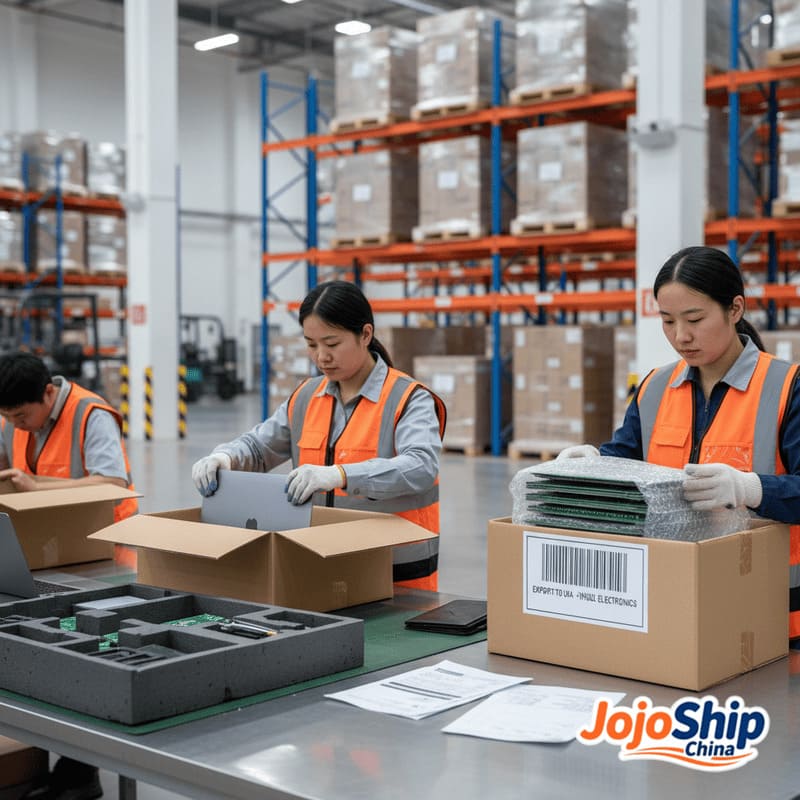
Having shipped thousands of electronics consignments from China to the USA over the years, I've learned which freight companies truly deliver on their promises when handling sensitive electronic goods. Let me share insights from my experience that can help you select the right partner for your specific electronics shipping needs.
What Companies Ship From China To USA?
The shipping market from China to the USA is flooded with options, leading many importers to choose based on price alone. This approach often results in service quality issues1, verborgen kosten2, and reliability problems3 that undermine your supply chain.
Major companies shipping from China to USA include global carriers like Maersk, MSC, COSCO, and CMA CGM for ocean freight, and DHL, FedEx, UPS for air express. Leading freight forwarders include Kuehne + Nagel, DHL Global Forwarding, Flexport, SEKO Logistics, Sinotrans, and JojoShip China, offering end-to-end logistics solutions and specialized services.
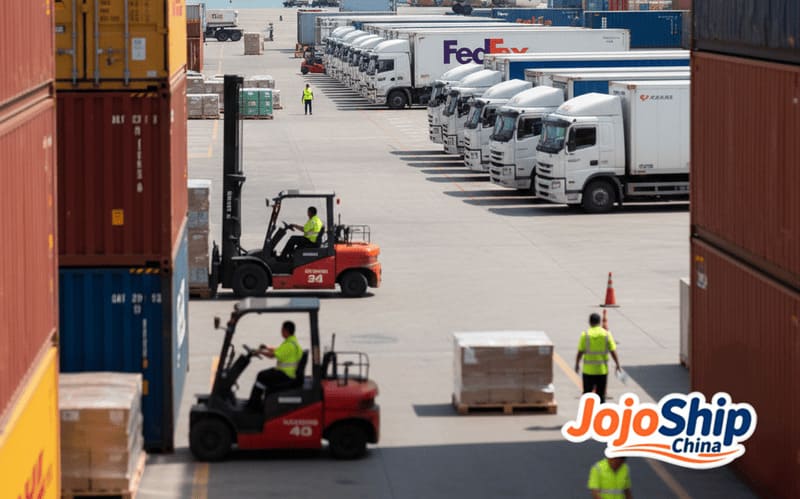
The China-USA shipping landscape includes a diverse mix of carriers, freight forwarders, and specialized logistics providers. Through my years managing JojoShip China and overseeing countless shipments across this vital trade lane, I've developed a clear picture of the key players and their unique strengths.
The shipping companies operating between China and the USA can be categorized into several main groups:
-
Ocean Carriers (Shipping Lines)
These companies own and operate container vessels and provide the actual ocean transportation service.Drager Market Share Speciale functies Electronic Shipping Capabilities COSCO Shipping ~13% Chinese state-owned, extensive port coverage Temperature-controlled containers4, special handling Maersk Line ~12% Integrated logistics services Advanced tracking5, secure containers MSC ~16% Largest global capacity Specialized equipment for high-value cargo CMA CGM ~11% Strong Asia-US routes Climate-controlled solutions Evergreen ~6% Reliable schedules Good handling for sensitive cargo ONE ~7% Japan-based alliance carrier Modern fleet with reliable service Hapag-Lloyd ~6% Premium services Special cargo handling expertise ZIM ~4% Express services on select routes Expedited options for electronics -
Air Carriers
For time-sensitive and high-value electronic shipments, these companies provide much faster transit times.Drager Service Types Electronics Specialization DHL Express Time-definite delivery Extensive experience with electronics FedEx Priority and economy options Special handling for high-value items6 UPS Worldwide services Strong customs expertise SF Express Chinese carrier with US service Growing electronics shipping focus Major Airlines (Cargo) Terminal-to-terminal Various specialized services -
Freight Forwarders with Electronics Expertise
These companies don't own transportation assets but arrange and coordinate shipments using various carriers.Forwarder Special Electronics Features Service Coverage Flexport Digital platform, end-to-end visibility7 Air, ocean, customs, fulfillment SEKO Logistics Electronic specialty, compliance expertise8 Global door-to-door service Kuehne + Nagel Temperature control, security protocols Comprehensive global services DHL Global Forwarding Secure handling, compliance services Worldwide coverage JojoShip China Specialized in China exports, electronics expertise Door-to-door, compliance support ARDI Logistics Electronics-focused solutions Customized shipping plans Tonlexing Secure electronic shipping procedures Multi-modal options Sinotrans Chinese logistics giant with US presence Full-service capabilities DFH Logistics Technology-driven solutions Air and ocean options SINO Shipping Compliance expertise for US market Comprehensive services -
Specialized Electronics Logistics Providers
Some companies focus specifically on electronics supply chains with tailored solutions.Company Specialisatie Key Benefits Global Unity Logistics E-commerce electronics Marketplace fulfillment integration Asiana USA Consumer electronics Supply chain optimization AEB Logistics Electronic components Technical compliance expertise8 CTSI Logistics High-value electronics Enhanced security protocols9 Crane Worldwide Technology logistics Time-critical solutions
When selecting a shipping partner for electronics, it's important to look beyond basic transportation capabilities. Based on my experience at JojoShip China handling sensitive electronic goods, the most critical factors include:
-
Customs Expertise: Electronics face stringent regulatory requirements including FCC-certificering10, safety standards, and intellectual property scrutiny. Companies like Flexport, SEKO, and JojoShip China maintain dedicated customs compliance teams specifically trained in electronics regulations.
-
Handling Capabilities: Electronics require special care to prevent static damage, moisture exposure, and shock protection. Carriers with specialized equipment and trained personnel make a significant difference in preventing damage.
-
Insurance Coverage: Electronics shipments typically have higher value-to-weight ratios, making appropriate insurance critical. The best providers offer tailored insurance solutions rather than basic coverage.
-
Security Protocols: Electronic goods are prime targets for theft. Companies like DHL Global Forwarding, Kuehne + Nagel, and JojoShip China implement enhanced security measures including sealed containers, GPS tracking, and monitored warehouses.
-
Documentation Expertise: Incorrect documentation for electronics can lead to customs holds, penalties, or even shipment rejection. Specialized forwarders understand the specific documentation requirements for various electronic categories11.
Before choosing any shipping company for your electronics, I recommend asking these specific questions:
- What percentage of their shipments involves electronics?
- Do they have dedicated staff trained in electronics handling?
- What is their claims ratio for electronics shipments?
- Can they provide references from other electronics shippers?
- What specific measures do they take to ensure compliance with US electronics import regulations?
Hoeveel kost vrachtvervoer van China naar de VS?
Pricing complexity and hidden charges plague electronics shipping from China. Many businesses receive misleadingly low initial quotes, only to face unexpected fees that erode profit margins12 and disrupt carefully planned budgets.
Freight shipping costs from China to USA for electronics range from $3-8/kg for air freight and $2,500-5,000 for a full container (FCL) by sea. Express courier (DHL/FedEx/UPS) for smaller electronics shipments costs $7-15/kg. Electronics typically require additional services like insurance (0.3-0.5% of value), customs compliance support ($150-300), and specialized packaging, adding 15-30% to base rates.
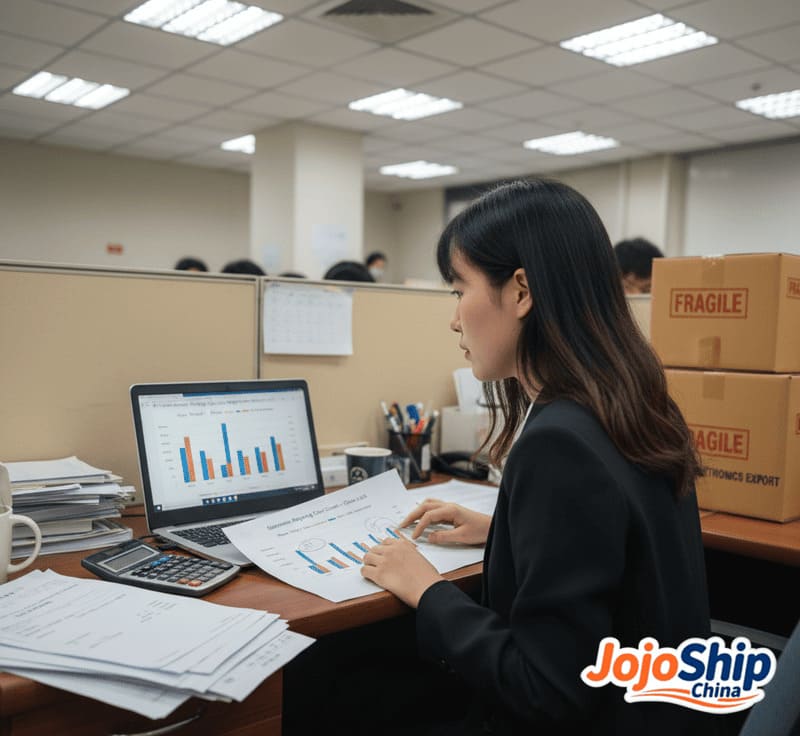
Shipping electronics from China to the USA involves specific cost considerations beyond standard freight rates. Drawing from my experience managing electronics shipments through JojoShip China, I can provide detailed insight into current market rates and the factors that influence them.
The cost of shipping electronics from China to the USA varies based on several key factors:
-
Shipping Method and Transit Time
Verzendmethode Doorlooptijd Base Rate Beste voor Express Koerier 1-5 days $7-15/kg Samples, urgent small shipments Luchtvracht 3-7 dagen $3-8/kg High-value, time-sensitive Zeevracht (LCL) 30-40 dagen $40-60/CBM Mid-sized, less urgent Sea Freight (FCL 20ft) 30-40 dagen $2,500-3,500 Larger volume Sea Freight (FCL 40ft) 30-40 dagen $3,500-5,000 Full container loads -
Electronics-Specific Surcharges and Services
Additional Service Typische kosten Necessity Insurance 0.3-0.5% of value Essential for electronics Lithium Battery Handling13 $75-250 per shipment Required for applicable items Anti-static Packaging $2-5 per carton Recommended for components FCC/FDA Documentation14 $150-300 Required for most electronics Security Surcharge $0.15-0.25/kg Standard for high-value goods Temperature Control15 15-25% premium For sensitive components -
Herkomst en bestemming
- Major electronics manufacturing hubs (Shenzhen, Shanghai) offer more competitive rates
- Destination delivery to major US population centers costs less than remote locations
- Warehouse-to-warehouse is cheaper than door-to-door service
For practical budgeting purposes, here are typical all-inclusive costs for common electronics shipments:
| Scenario | Express Koerier | Luchtvracht | Sea Freight |
|---|---|---|---|
| 50kg of smartphone components | $800-1,200 | $500-700 | Not practical |
| 500kg of consumer electronics | Not practical | $2,500-4,000 | $700-900 (LCL) |
| 1 container of laptops (20ft) | Not practical | $12,000-18,000 | $3,500-4,500 |
| 1 container of TVs (40ft) | Not practical | $20,000-30,000 | $4,500-6,000 |
Several factors unique to electronics shipping affect pricing:
-
Value-to-Weight Ratio16: Electronics typically have high value in relatively light packaging. This affects both insurance costs and the economical choice of shipping method.
-
Regulatory Compliance: Electronics require additional documentation and often inspection for FCC, UL, and other certifications. These compliance costs add to the overall shipping expense.
-
Speciale behandelingsvereisten:
- Static-sensitive components require anti-static packaging
- Items with lithium batteries face additional regulations and fees
- Fragile displays need enhanced protection
-
Seasonal Factors:
- New product launches often coincide with peak shipping seasons
- Consumer electronics demand spikes before holiday periods
- Manufacturing cycles around Chinese holidays affect capacity
At JojoShip China, we've developed an "Electronics Total Landed Cost Calculator" that helps clients understand the complete picture beyond just freight rates. This includes:
- Base freight costs
- Insurance appropriate for electronics value
- Regulatory compliance fees
- Specialized handling charges
- Customs duties and taxes
- Last-mile delivery
For businesses regularly shipping electronics, I recommend these cost-saving strategies:
- Consolidatie17: Combining shipments to reach weight breaks or container optimization
- Advanced booking: Securing space 2-3 weeks ahead can save 10-20% on air freight
- Packaging optimization: Reducing dimensional weight through efficient packaging
- Direct routing: Avoiding transshipment points where electronics may face additional handling
- Annual contracts: For consistent shippers, negotiated rates can save 15-25%
One common mistake I see is choosing shipping methods based solely on the base freight rate. For electronics, the lowest freight rate often results in higher total costs when factoring in increased risk of damage, longer transit times affecting inventory costs, and greater chance of customs delays.
Can You Ship Electronics From China?
Many businesses hesitate to import electronics from China due to concerns about customs restrictions, compliance issues, and safety regulations. This uncertainty leads to missed opportunities or costly mistakes when attempting to navigate complex import rules.
Yes, you can ship electronics from China to the USA, but specific requirements must be met. Most electronic devices need FCC certification, and products with lithium batteries require special labeling and documentation. UL certification is also important for many electronic products. Working with a freight forwarder experienced in electronics compliance helps ensure smooth customs clearance.
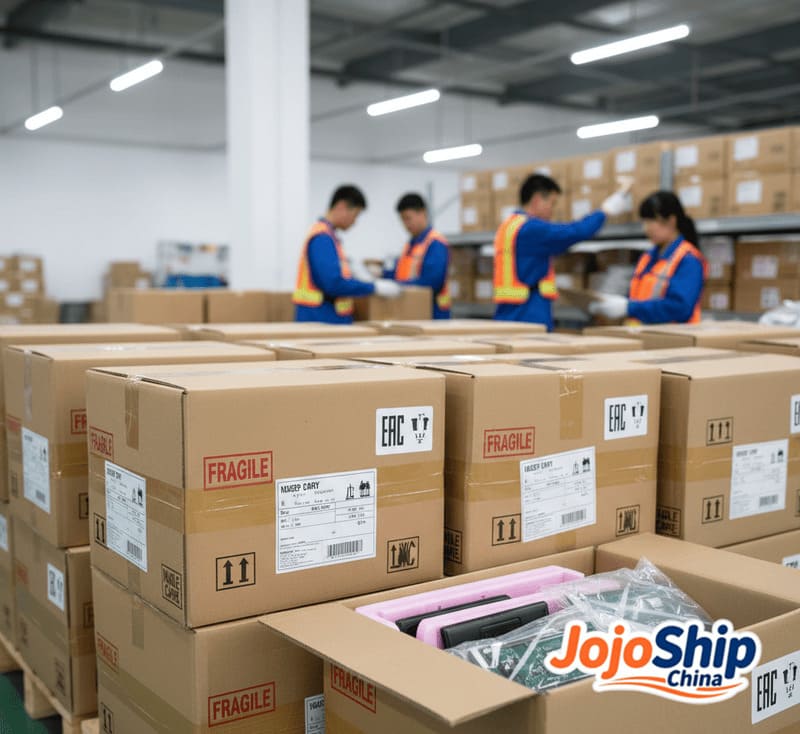
Shipping electronics from China to the USA is entirely possible and can be very profitable, but it requires navigating a maze of regulations and requirements. Through my years managing electronics shipments at JojoShip China, I've developed a clear understanding of what's needed to ensure successful imports.
The key requirements for shipping electronics from China to the USA include:
-
Regulatory Compliance and Certification
Certification Applies To Requirements FCC Most electronic devices Testing and certification before import UL Products connecting to power Safety certification, often voluntary but expected RoHS Electronic components Restriction of hazardous substances CPSC Consumer electronics Safety standards compliance FDA Medical electronics Registration and approval process -
Battery Regulations
Electronics containing lithium batteries face particularly strict regulations:- UN38.3 certification18 required for lithium batteries
- Specific labeling requirements
- Documentation including material safety data sheets19
- Quantity limitations per package
- Special handling requirements
-
Intellectual Property Considerations
- Electronics must not infringe on US patents, trademarks, or copyrights
- Customs can seize counterfeit or infringing products
- Proper licensing documentation may be required
-
Documentation Requirements
Document Purpose Special Requirements for Electronics Commercial Invoice Declares value and content Must detail model numbers, specifications Packing List Details quantity and packaging Should include serial numbers for high-value items Bill of Lading/Airway Bill Transport contract Special handling instructions Certificate of Origin Verifies country of manufacture Particularly important for electronics FCC Declaration/Certification Proves compliance Required for most electronic devices Safety Data Sheet For batteries/hazardous components Required for lithium batteries -
Import Duties and Taxes
Electronics face varying duty rates based on:- Harmonized Tariff Schedule (HTS) classification20
- Country of origin (China often faces higher tariffs)
- Any applicable trade remedies or additional duties
Based on my experience at JojoShip China, here are practical strategies to ensure successful electronics shipping:
-
Pre-Shipment Compliance Verification
Before any electronics leave China, verify:- All required certifications are complete and documented
- Product labeling meets US requirements
- Testing has been performed by accredited laboratories21
-
Proper Classification and Valuation
- Accurate HTS code assignment is critical for electronics
- Proper valuation ensures correct duty assessment
- Misclassification is a common cause of customs delays
-
Specialized Packaging for Electronics
- Anti-static materials for sensitive components
- Moisture barriers for humidity-sensitive items
- Shock-absorbing packaging for fragile displays/components
- Temperature-stable containers for certain components
-
Strategic Shipping Method Selection
Different electronics benefit from different shipping methods:- High-value, lightweight items (smartphones, components) → Air freight
- Larger consumer electronics (TVs, appliances) → Ocean freight
- Urgent or sample shipments → Express courier
- Products with lithium batteries → Often easier via air with proper documentation
-
Customs Brokerage Specialization
- Use brokers with electronics experience
- Pre-file documentation when possible
- Consider customs bonds for regular importation22
One strategy that has proven particularly effective for JojoShip China clients is implementing a "compliance-first" approach. This involves:
- Creating a comprehensive compliance checklist specific to each electronic product23
- Conducting pre-production compliance reviews24
- Building relationships with testing laboratories in China
- Maintaining a database of product certifications and renewals
What Is The Most Common Shipping Route From China To The USA?
Shippers often select suboptimal routes for their electronics, resulting in longer transit times, higher costs, and increased risk of damage. Understanding the main shipping corridors is essential for optimizing your supply chain.
The most common shipping route from China to the USA is from the Port of Shanghai to the Port of Los Angeles/Long Beach, handling roughly 40% of all China-USA container traffic. For air freight, the Shanghai (PVG) to Los Angeles (LAX) route is most heavily utilized. Electronics shipments commonly originate from manufacturing hubs in Shenzhen, Guangzhou, and Shanghai, with secondary routes including Ningbo to Seattle and Shenzhen to New York.
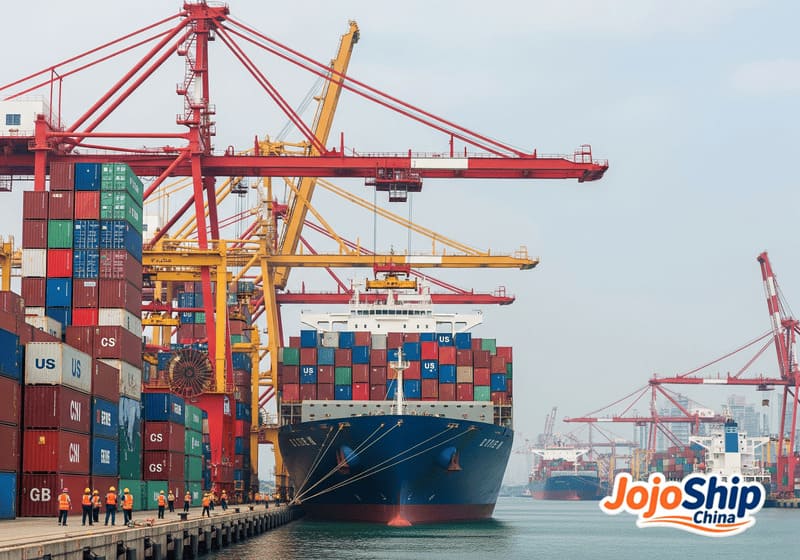
Throughout my years at JojoShip China coordinating thousands of electronics shipments, I've gained deep insight into the major shipping routes connecting China and the USA. The optimal path for your electronics depends on origin, destination, urgency, and volume.
The main shipping channels between China and the USA can be broken down into several key corridors:
-
Ocean Freight Primary Routes
Origin Port (China) Destination Port (USA) Doorlooptijd Vessel Frequency Electronics Volume Shanghai Los Angeles/Long Beach 14-18 days Daily departures Highest volume route Ningbo Los Angeles/Long Beach 15-19 days 5-6 weekly High volume Shenzhen (Yantian) Los Angeles/Long Beach 16-20 dagen 4-5 weekly Major electronics hub Qingdao Los Angeles/Long Beach 16-20 dagen 3-4 weekly Mixed cargo Shanghai Seattle/Tacoma 14-18 days 2-3 weekly Growing importance Ningbo Oakland 18-22 days 2 weekly Alternative West Coast Shanghai New York/New Jersey 30-35 days 3-4 weekly Largest East Coast route Shenzhen New York/New Jersey 32-38 days 2-3 weekly Premium East Coast route -
Air Freight Main Routes
Origin Airport (China) Destination Airport (USA) Flight Time Frequency Electronics Specialization Shanghai (PVG) Los Angeles (LAX) 12-13 hours Multiple daily Highest volume electronics route Hong Kong (HKG) Los Angeles (LAX) 13-14 hours Multiple daily Premium electronics Shenzhen (SZX) Los Angeles (LAX) 14-15 hours Daily Consumer electronics hub Shanghai (PVG) Chicago (ORD) 14-15 hours Daily Electronics distribution Beijing (PEK) New York (JFK) 14-15 hours Daily Mixed cargo Guangzhou (CAN) Los Angeles (LAX) 13-14 hours Daily Growing electronics route Shanghai (PVG) New York (JFK) 15-16 hours Daily East Coast distribution -
Secondary and Emerging Routes
- Xiamen to Los Angeles (growing electronics exports)
- Shenzhen to Dallas (emerging tech corridor)
- Shanghai to Atlanta (distribution hub access)
- Wuhan to Chicago (developing interior China exports)
The selection of shipping route for electronics is influenced by several factors:
-
Electronics Manufacturing Clusters in China
- The Pearl River Delta (Shenzhen, Guangzhou, Dongguan) specializes in consumer electronics and components
- The Yangtze River Delta (Shanghai, Suzhou, Hangzhou) focuses on higher-end electronics and semiconductor products
- Chengdu and Chongqing are emerging as inland electronics manufacturing hubs
-
Distribution Centers in the USA
- West Coast: Major electronics distribution in California, Washington, and Oregon
- Midwest: Chicago and Memphis serve as key distribution hubs
- East Coast: New Jersey and Georgia handle significant electronics volume
-
Route Selection Strategy for Electronics
For high-value electronics, I typically recommend:- Shorter routes with fewer transshipments to reduce handling
- Routes serviced by carriers with specialized electronics experience
- Ports/airports with advanced security and climate control facilities
-
Seasonal Considerations
- Peak season (August-November) sees congested primary routes
- Alternative routing becomes valuable during Chinese New Year
- Weather considerations (typhoon season, winter storms) affect reliability
At JojoShip China, we've developed a route optimization system specifically for electronics that analyzes:
- Historical performance data for each carrier on specific routes
- Weather pattern impacts on transit reliability
- Port/airport infrastructure for handling sensitive electronics
- Customs clearance efficiency for electronics at each entry point
For companies shipping electronic components or finished products, route selection should consider these specialized factors:
-
High-Value Protection
- Some routes offer better security and monitoring for premium electronics
- Certain carriers provide specialized high-value cargo services on specific routes
-
Temperature and Humidity Control
- Northern routes may experience extreme temperature variations
- Southern routes may have higher humidity concerns for sensitive components
-
Customs Efficiency
- Some US ports have specialized electronics inspection teams
- Certain routes face more intensive examination for IP concerns
-
Last-Mile Connectivity
- Proximity to final distribution networks
- Specialized electronics handling capabilities
One valuable strategy for electronics shippers is route diversification. Rather than depending on a single corridor, spreading shipments across 2-3 routes can mitigate disruption risks. During the 2021 port congestion crisis, JojoShip China clients who had established alternative routing options managed to maintain supply chains while competitors faced weeks of delays.
Finally, the development of new China-USA shipping routes continues to evolve. The Arctic Northern Sea Route25 is beginning to see limited commercial traffic, potentially reducing transit times by 7-10 days compared to traditional routes. While still developing, this may become significant for time-sensitive electronics in the coming years.
Conclusie
The top freight companies for shipping electronics from China to USA include Flexport, SEKO Logistics, Kuehne + Nagel, DHL Global Forwarding, and JojoShip China, offering specialized services at rates from $3-8/kg (air) or $2,500-5,000 (ocean container) with necessary compliance support and proper handling for sensitive electronic components.
-
Understanding how companies tackle service quality issues helps you avoid unreliable partners and ensures your supply chain remains efficient and trustworthy. ↩
-
Learning about hidden fees can help you budget accurately and avoid unexpected costs that could impact your profitability. ↩
-
Exploring reliability measures helps you select partners that minimize delays and disruptions in your supply chain. ↩
-
Temperature control is crucial for sensitive electronics; finding the right provider protects your goods from damage during transit. ↩
-
Advanced tracking gives you real-time visibility, helping you manage inventory and respond quickly to any shipping issues. ↩
-
Special handling reduces the risk of loss or damage, ensuring your valuable electronics arrive safely and securely. ↩
-
Digital platforms streamline logistics, offering transparency and control over your shipments for better decision-making. ↩
-
Compliance expertise helps you avoid regulatory pitfalls, customs delays, and penalties, ensuring smooth import of electronics. ↩ ↩
-
Enhanced security protects your shipments from theft and tampering, giving you peace of mind for high-value goods. ↩
-
FCC certification is mandatory for many electronics; understanding it helps you avoid customs issues and legal complications. ↩
-
Correct documentation prevents customs holds and penalties, ensuring your shipments clear smoothly and on time. ↩
-
Understanding how to avoid hidden charges is crucial for maintaining healthy profit margins and preventing budget overruns in electronics shipping. ↩
-
Understanding lithium battery regulations is essential for compliance and safety when shipping electronics containing batteries. ↩
-
Proper documentation is vital for regulatory compliance, preventing shipment holds and ensuring legal importation of electronics. ↩
-
Temperature control protects sensitive components from environmental damage, ensuring product quality and reliability upon arrival. ↩
-
Understanding this ratio helps businesses choose the most cost-effective shipping method for high-value, lightweight electronics. ↩
-
Consolidating shipments can optimize container space and weight breaks, leading to significant savings on freight costs. ↩
-
UN38.3 certification is mandatory for lithium batteries, helping you avoid fines and shipment rejections at customs. ↩
-
Material safety data sheets are required for hazardous components, ensuring safe handling and regulatory compliance. ↩
-
Correct HTS classification determines your duty rates and helps prevent costly misclassification penalties. ↩
-
Working with accredited labs guarantees your products meet US standards, reducing the risk of customs issues and recalls. ↩
-
Customs bonds facilitate smooth, repeated imports and help you avoid delays or penalties for high-volume shipments. ↩
-
A tailored compliance checklist streamlines your import process and minimizes regulatory risks and delays. ↩
-
Pre-production compliance reviews catch issues early, saving you time and money on rework or rejected shipments. ↩
-
Explore this emerging route and its potential to reduce transit times for time-sensitive electronics shipments. ↩




